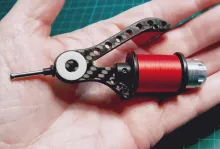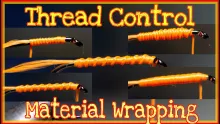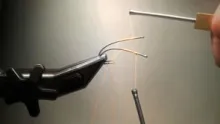The nerdy look at tying threads plotting their thickness, Denier and breaking strength in scatter charts to show correlation. There is none!
OK, let's get really nerdy here! This is not for the faint of heart, I admit, but bear with me.
These charts plot different physical aspects and specifications of the threads, placing them in a so called scatter chart, which is a great way to find correlations between data. If there is any system in the plotted data, it typically aggregates in groups or along lines or curves.
As you can see there is no such grouping or order in any of the charts, which are chaotic to put it mildly. Of course it's not totally fair to mix all threads from all brands and expect a pattern, but even picking out a certain brand (click the brand links next to the charts) or focusing on a given brand (same color dots), you will find no system.
A single manufacturer, Lagartun, has an almost linear correlation between thickness and Denier as well as breaking strength (seen when you look at polyester threads by themselves), and Veevus has a very nice and almost linear correlation between thickness and strength when you look at the polyester and GSP threads separated, but threads from the rest of the manufacturers are spread out like shots from a shotgun, indicating no consistency in thickness and strength or denier and physical thickness.
As you can see there is no such grouping or order in any of the charts
In the same manner mono threads from various manufacturers seem to have a nice correlation between diameter and strength, which is no surprise. It is after all a uniform, single nylon filament, basically made in the exact same manner from the same material.
Breaking strength vs. diameter comparison
This chart shows all tying threads placed according to thickness and breaking strength. Thinner and weaker threads are low/left, stronger and thicker threads are high/right.
Denier vs. diameter comparison
This chart shows the relation between Denier and thickness.
If there was a correlation between the compared data, dots would be on a line or a curve - or at least on several lines or curves, clustered based on the thread material.
General tying thread notes
Note
The thread data is frequently updated as new sources or products appear - or old sources reveal new information.
I try to follow the development, but it's a tough job!
If you see any errors or missing products, feel free to contact me at martin@globalflyfisher.com.
Update Jan 2018: My own measurements in the table are all in millimeters, but for some reason the system was set up to do a calculation on the diameter in inches where available, which was the first information I got from a variety of sources before I started measuring the threads myself.
This led to some errors, like the UNI-thread 6/0 being thinner than the 8/0 - which it isn't.
The table now lists the actual measured diameters in millimeters wherever that has been made by me, then selects the specified diameter in millimeters if available and finally falls back to a calculation based on the specified diameter in inches when only that is available.
Material
Mono is monofilament nylon. Silk is natural silk. The rest are synthetic multifilament threads produced using different methods. Two threads made from the same material can be very diferent.
Aught
The most common way to indicate thickness. Not a physical standard. Larger number means thinner thread, so 8/0 is thinner than 6/0.
Denier
The weight in grams of 9000 meters of thread. A physical standard used in the textile industry, but not an indication of thickness or strength.
Dia.
Diameter in millimeters (mm). As specified by the manufaturer or measured by me or others.
Test
The breaking strength or test of the thread in grams (g). The number is the highest found if values from different sources differ.
Denier/mm
A simple calculation of what the Denier would be if the thread was 1 millimeter thick, and a way to compare the Deniers for the different threads. Ideally this number should be the same for threads made from the same material, but the numbers clearly indicate that the Denier number does not help us much in comparing even almost identical threads. Denier and thickness are NOT correlated.
Denier and thickness are NOT correlated.
Absolute strength*
The absolute breaking strength of the thread compared to all other threads and not taking diameter or material into consideration..
Relative dia
A visual indication of the relative thickness of the thread compared to others. Not to measure in any way! Just a visualization.
Relative strength*
An indication of the relative strength of the thread compared to its diameter and the other threads. Not an absolute measurement! Thin threads can be as relatively strong as thick ones. The numbers indicate breaking strength in relation to diameter.
Flatability **
The thread's ability to flatten when tied in. Sometimes requires the thread to be untwisted.
Splitability **
The thread's ability to split when used for the split thread dubbing technique.
Smoothness **
How slippery or smooth the thread is against the hook shank or materials. Its ability to "grip" materials.
*
The textual strength indications are based on calculations and data comparisons and the groups are defined by the me. They are objective, based on numbers, but you may disagree with my scale.
**
These properties are assessed by me based on threads that I have tied with. I have only added data for unseen mono threads, which are basically all very smooth, round and can't be split.
Disclaimer
I have researched very thorughly to collect and confirm the data in the tables, and gathered and compared and averaged numbers and information from many sources - and measured thread myself when possible. If numbers have varied, I have selected the "best" number for the thread (thinnest, strongest). I'd be very happy to get missing (or more correct) numbers from the manufacturers who haven't published such information - or from other tyers or dealers who have measured or tested the threads. The more precise this info, the better for the fly-tyers. Contact me via e-mail martin@globalflyfisher.com.
Articles in this series
- Log in to post comments







